Producing strong, sweet, and stain-free Tomatoes is every farmer’s dream. However, like vegetable gardeners, Tomato gardeners face numerous frustrations such as poor quality, low yield, and diseases. Many such factors also relate to soil quality, nutritional level, and pH level. Hence, proper soil preparation is one of the keys to success in healthy Tomato plants and a bountiful crop. Let’s check out more information about the soil preparation for Tomato plants.
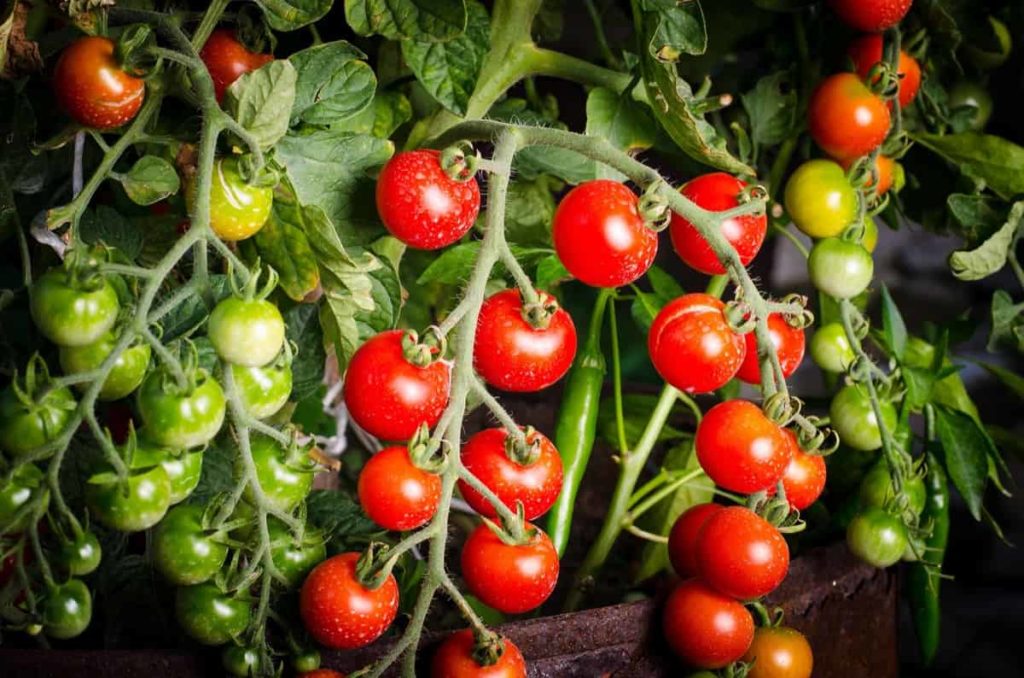
The nitrogen, phosphorus, and potassium balance are essential for your Tomato plants to produce many healthy fruits. Proper soil preparation will control the growth of weeds so that your new plants are not competing with weeds for nutrients and water resources. Tomato seedlings need strong and direct light to grow well.
If you want to plant them on open land, choose an area where plants can get at least 6 hours of direct sunlight. On the other hand, if someone is growing Tomatoes in a greenhouse, it is pretty difficult for them to get proper natural light, so one can use artificial light to ensure that plants get 14 to 18 hours of light daily.
Soil pH for Tomatoes
A proper pH is an essential ingredient for preparing the soil for Tomato planting. If you are planting a large number of Tomatoes, check several areas in the planting area. A neutral pH level is 7.0. A number less than 7.0 indicates acidic soil; the lower the number, the more acidic the soil is. More than 7.0 numbers indicate alkaline soil; the higher the number, the more alkaline soil. Tomatoes need slightly acidic soil with pH levels between 6.0 and 7.0, with maximums between 6.5 and 7.0.
Make appropriate adjustments if your soil pH is not within this limit. To reduce your soil pH, work as sulfur in the soil. To raise your soil pH, work lime in the soil. You can also adjust the pH with eggshells or coffee grounds between 6.2 and 6.8. If your soil’s pH is less than 6.2, mix in a powdered eggshell for every 100 square feet in a ratio of 0.45 kg. For soil with a pH above 6.8, you need to make it more acidic.
Mix equal parts of water and cold coffee in a water box and apply it to the soil. If you have a garden of about 20 square feet, mix in about 90 grams of eggshell powder. After applying a mixture of egg peel or coffee, turn the soil over and mix it. Retest the soil before planting your Tomatoes to see if the pH level is between 6.2 and 6.8.
Soil Preparation for Tomato plants in pots
You should need a good potting mix when if you want to grow Tomatoes in containers/pots. Potting mix is a soilless mixture of different organic and inorganic elements. Potting mix is a balanced combination of these ingredients:
- Peat moss – It is a dead fibrous material that can hold water and other nutrients for a long time. It also promotes soil structure and consistency. The peat moss remains in the soil for many years. You should add lime and other ingredients to bring a balance to the potting mix.
- Coconut fiber – It is also known as coir fiber or coco-coir, or coco peat is the best alternative source of peat moss, perlite, and vermiculite. The coco coir naturally holds a pH between 5.2 and 6.8, suitable for growing most plants. Also, the coir fiber has some natural ability to grow new plants.
- Vermiculite – Vermiculite is a soft brown sponge soil addition that is relatively sterile. It has a bit of natural pH and is very lightweight. It can maintain water for a long time and control soil moisture. Also, this is a suitable medium for sprouting seeds which is the best suit for Tomatoes.
- Perlite – It is a white color, hard, and highly porous material used to lighten potting soil. It is very lightweight and provides enough air in the potting mix. It also helps in developing plant roots and is suitable for alkaline-loving plants. Moreover, it releases its remaining water quickly.
- Sand – This is the cheapest addition used in potting mix for aeration. Sand can gain the weight of the container, so use it while maintaining the appropriate ratio. Try using thick sand, silica sand, or beach sand to mix your potting mix.
- Compost – It is one of the significant additions to the potting mix. It provides essential nutrients to plants and keeps soil moisture.
- Other ingredients – Based on your potting mix and plant type, you can add small quantities of fertilizer or slow-release nutrients to this mix.
- Water holding gels– Water-holding gel in the potting mix is becoming famous for home gardeners. These gels can absorb water beyond its size and release it slowly.
In case you missed it: Best Tomato Varieties in India: Hybrid, Rainy Season, and High Yield
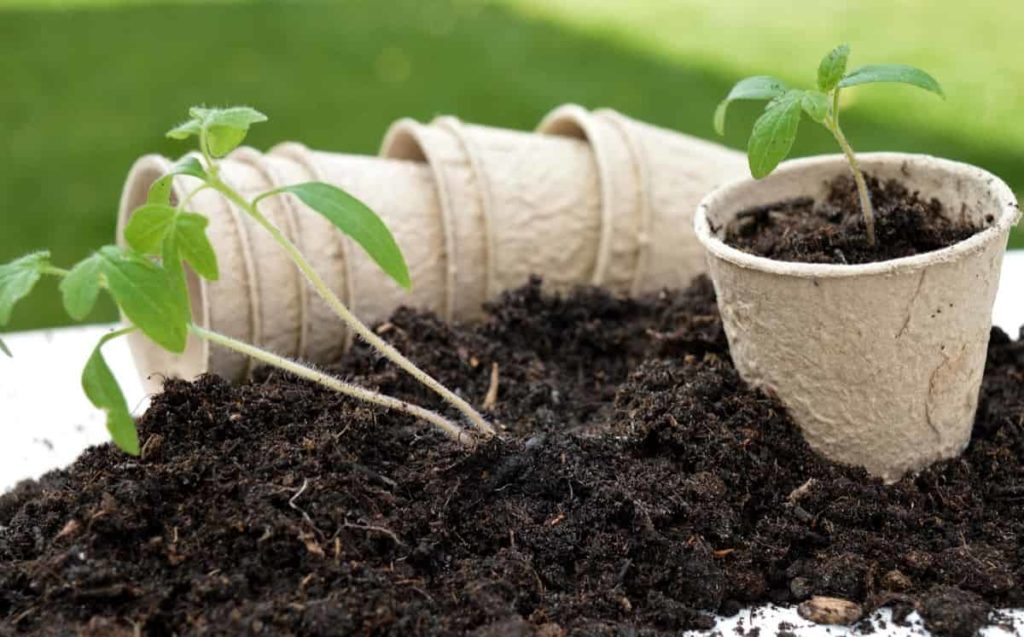
Best soil mix for Tomatoes
To make an excellent potting mixture, mix the equal parts of peat moss or coco-coir, compost, and sand or perlite. Depend on the proper portion of vermiculite in the plants you grow. Add organic ingredients or other nutrients if needed. A good potting mix always maintains moisture, stays wet-free, and maintains a good drainage system and proper soil aeration. If your potting mix contains the above elements and meets the state of a good potting mix, it will be an excellent source for growing Tomatoes.
You can also buy potting soil from local garden centers or online stores. Different types of potting mixes are available, and prices vary mainly in soil quality. The standard potting mix is much less expensive. But you should add some fertilizer, nutrients, and other elements to meet the quality of a good potting mix. Various branded commercial mixes are also available in local and online stores. Select correct, and compare with the quality of a good potting mix.
Preparation of soil for growing Tomatoes on the ground
Remove anything that is not dirty from the garden plot. Use a garden hoe to scrape through dirt and look for sticks or debris that you can remove. Next, use your garden dock to break the complex cluster of land in soft dirt. Large clods of soil can make it difficult for your Tomato plant roots to enter the ground when you plant them. Next, add 4 inches of organic humus material to the ground, such as finished compost, aged manure, sphagnum peat, leaf mold, dried grass clippings, or dead plant material.
Add the humus material to the soil thoroughly from 8 to 12 inches. Apply the garden fertilizer to the soil a few weeks before planting, immediately after adding the humus material. Use low nitrogen fertilizers such as 8-32-16 or 6-24-24 and avoid ammonia fertilizers. Apply fertilizer per 100 square feet at 1 to 1.2 kg. Up to a depth of 6 inches up to the planting area, fertilizer is readily available to plant roots.
In case you missed it: Stages of Growing Tomatoes from Seed: Steps, Time, and Lifecycle
Land preparation
Tilling is considered an old tradition and has been abolished by many. However, tilling provides considerable benefits. Such benefits include aeration of the soil, nutrients, organic materials, and the mixing of fertilizers. Tilling also helps in cutting and killing weeds that compete with plants in the use of water and nutrients.
Rolling garden carts, wheelbarrows, or tractors above the garden squeeze the air with soil, thus requiring tilling. Sometimes the crust surfaces can be formed over the soil, which acts as a barrier to water entry. Tilling softens the surface, penetrates the water quickly, and the soil becomes so soft that Tomato roots can penetrate easily.
Dig holes or trenches – Dig holes or trenches deep after verifying soil type, pH, and nutrient levels. It is essential to break trenches or holes as it prevents plant overcrowding. Ensure a space of 2 feet between each seedling and maintain the same distance between the rows. Maintain this distance to allow the plant to be out of the branch and proper circulation of air. The overcrowding of Tomato plants prevents growth and puts them at greater risk of diseases.
When digging the hole, consider the height of the seedlings. Two-thirds of the seedlings must be buried in the ground. If the seedlings are long, make deep holes, but if they are small, one should dig shallows. Unlike other seedlings that die when planted deep in the soil, Tomatoes vary as they sprout roots with the buried stem. Additional roots absorb more minerals that lead to healthy plants, strengthen the plant to help more fruits, and help it avoid hot weather conditions.
Soil composting for Tomatoes
It is essential to consider whether soil contains nutrients as Tomatoes need phosphorus, potassium, and nitrogen. If the soil is low in nutrients, one can use organic or non-organic sources to increase soil. It is also essential to the soil as it helps mix nutrients, fuelling soil and soft for water and Tomato roots to penetrate easily. Compost is a broken organic matter. It is not exceptionally high in nutrients, but it is a beautiful way to improve your soil.
In case you missed it: Guide to Growing Tomatoes in Florida: In Winter, Summer, in Backyard and Containers
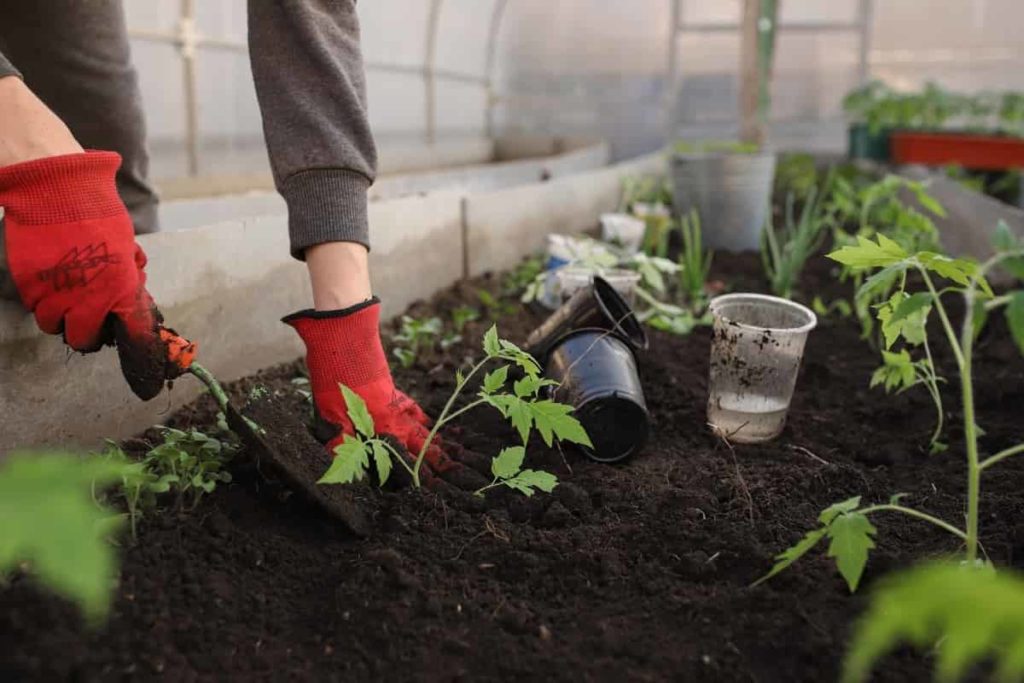
Compost improves soil structure, increases its cultivation, helps maintain nutrients, reduces compaction, attracts earthworms, increases microbes, and protects plants from disease. Adding compost is the only most crucial step you can take to prepare your soil to plant Tomatoes. When you start piling your compost at any time of the year, you can save money and make your compost.
The best soil amendments for Tomatoes to add to your soil are compost, manure, and dry timed fertilizer. Adding compost and manure will attract earthworms, which helps nutrients access your Tomato plants. Chicken manure is ideal, horse manure is a close second, and both are better than cow manure. The best fertilizer for Tomatoes needs to be high in nitrogen; cow manure is low in nitrogen.
Soil amendments for Tomatoes
The soil should have balance nutrients like potassium, phosphorus, and nitrogen to grow well.
Nitrogen – Nitrogen helps your Tomatoes maintain healthy, green leaves. Yellow old leaves and slow growth indicate a lack of nitrogen. Be careful; when you apply too much nitrogen before the fruit sets, the stem becomes quite large; the leaves are dark green and soft, and very few if there is a flower. Tomatoes require about 340 to 450 grams of nitrogen per 500 square feet. Add nitrogen to the soil shortly before planting.
Some organic sources of nitrogen are:
- Alfalfa meal
- blood meal
- Compost
- Feather meal
- Fish meal
- Legumes
- Leaf mold
In case you missed it: The Best Fertilizer for Tomatoes in Pots
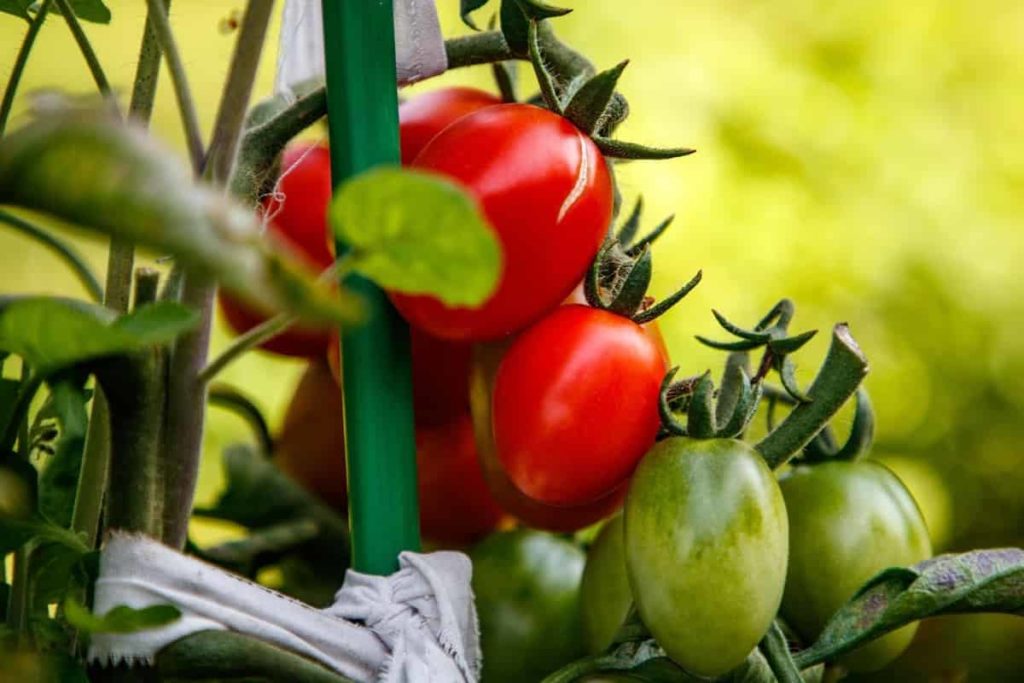
Some inorganic nitrogen sources are:
- ammonium nitrate
- ammonium sulfate
- Calcium Nitrate
- potassium nitrate
- sodium nitrate
- urea
Phosphorus – Phosphorus helps your Tomatoes develop strong root systems, create disease resistance and form fruits and seeds. Slow, stopping the growth, and red stems and leaves indicate a lack of phosphorus. Add the phosphorus-containing fertilizers to the soil before planting them instead of spraying them on the ground.
Some organic fertilizer sources of phosphorus are:
- Bone meal
- Compost
Some inorganic phosphorus sources are:
- Rock phosphate
- Superphosphate
Potassium – Potassium helps boost growth and disease resistance in your Tomato plants. Weak plants and slow growth indicate a lack of potassium. In addition, the leaves will turn brown when lacking potassium. A straightforward way to modify soil is to add wood ash, which is 5% potassium. The best rate is about 4.5 to 6.8 kg for a 300-square-footbed.
Some organic fertilizer sources of potassium are:
- Wood ash
- Granite dust (also known as rock potash)
Some inorganic potassium sources are:
- Potassium sulfate
- Rock sand
Soil recipes for Tomato plants
- Potting Mix 1: Garden soil, sphagnum peat moss, perlite, vermiculite, or sand.
- Potting Mix 2: Garden soil, powdered eggshells, bone meal, and manure
- Potting Mix 3: Pre-soaked coir peat, vermiculite, compost, and vermicast (humus)
Mix them all (separately) and save them to a container.
What to do with soil after growing Tomatoes
Crop rotation help restore nutrients in the soil, which improves the production of Tomatoes and other plants. You can choose any legume crop to rotate with Tomatoes. Beans include Peas, Beans, Peanuts, Clover, and alfalfa. These crops will help restore nitrogen to the soil when planted after Tomatoes. You can also plan a 3, 4, or 5-year crop rotation schedule to further reduce the risk of disease.
In case you missed it: Tomato Growing Tips, Ideas, Secrets, and Techniques
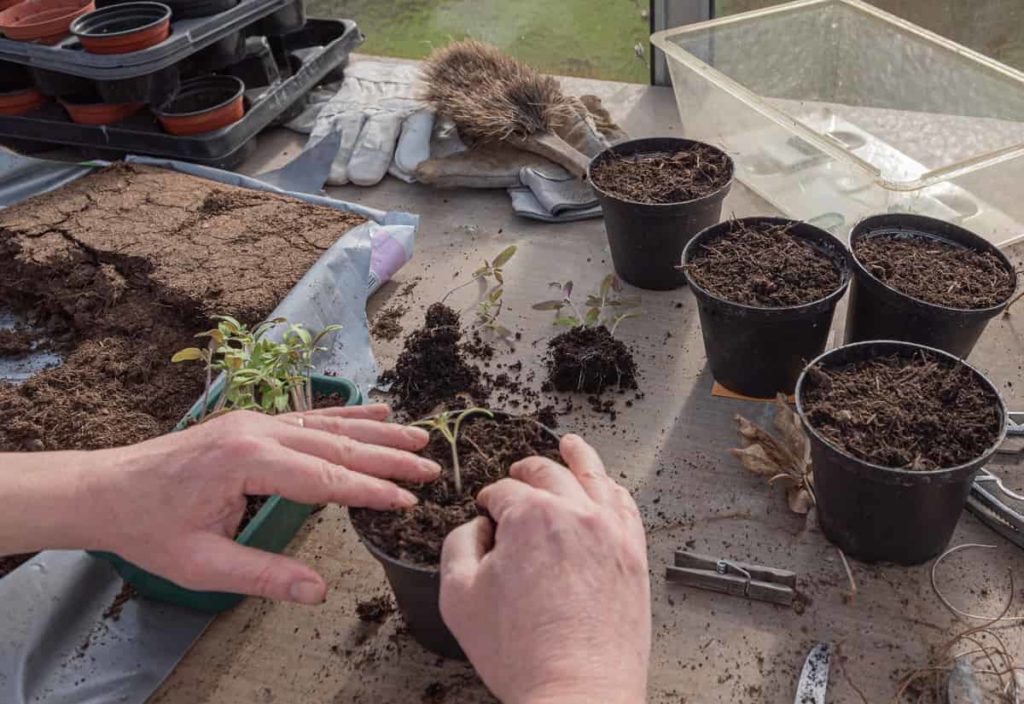
Legumes include plants such as:
- Alfalfa – A legume that is known as Lucerne. The deep roots of alfalfa also help it draw nutrients from the depths of the soil. It will allow him to access soil resources that shallow-rooted plants cannot do.
- Beans – Legumes that grow in pods, like peas. Green beans are a type of beans, and they come in both Pole and Bush varieties. Pole pods are long, climb a pole or trellis, and produce pods for a longer period than bush beans. Bush beans grow, spread, and cover an area more than the poles. Poles are the better option if you want to save space and make harvesting easier on yourself.
- Clover – A legume with specific 3-section leaves, often used as food for cattle.
- Peas –Legumes that grow in edible beans. Peas pods grow on long climbing vines, so using the trellis for support when growing peas is a good idea.
- Peanuts –Peanuts whose leaves grow above the ground and whose beans grow underground. It means that beans will restore nitrogen to the soil that has been depleted from other crops, such as Tomatoes or Broccoli.
If you want to rotate the Tomatoes crop over a long period of four years or five years, you can plant them in the following order:
- Brassica – Crops like Broccoli, Cauliflower, Cabbage, and Brussels sprouts.
- Cucurbits – Crops like Cucumber, Melon, and Squash.
- Root crops – Crops that grow on the ground, such as Carrots, Turnip, Radish, and Beetroot.
- Broccoli Seed Germination and Selection
- Asparagus Seed Germination and Variety Selection
- Seasonal Flower Gardening: Best Practices for Spring, Summer, Fall, and Winter
- How to Grow Hibiscus from Flower
- Plantation Ideas for Home Decoration: A Beginners Guide
- Flower Garden Designs and Layouts for Beginners
- Planting and Spacing Techniques in Papaya: A Beginner’s Guide
- Growing Gold: Essential Techniques for Planting Pineapples
- How to Make Kalanchoe Plant Bushy: Home Remedies and Solutions
- 11 Reasons Why Your Gardenia is Not Blooming: Home Remedies and Solutions
- Eco Elegance: The Guide to Designing a Drought-Tolerant Landscape
- Gardening on a Slope: Strategies for Hillside Landscaping
- Nourish and Flourish: Top Organic Mulches for Thriving House Plants
- Everything You Want to Know about Indian Mogra Flower: Discover Uses and Growing
- Green Thumb Success: Expert Tips for Cultivating Greenhouse Pumpkins All Year Round
- Maximize Growth & Flavor: The Ultimate Guide to Companion Planting in Herb Gardens
- How to Control Rhododendron Problems Naturally: Home Remedies and Organic Ways to Fix Them
- Natural Magic: The Remarkable Benefits of Cinnamon for Plants
- Best Steps to Revive Dying Tulip with Natural and Organic Treatment
- 10 Reasons Why Your Angel Trumpet is Not Blooming: Remedies and Treatment
- How to Fix Periwinkle Leaf and Flower-Related Problems: Natural Remedies and Solutions
- How to Fix Zinnias Leaf and Flower Problems: Discover Natural and Home Remedies
- Organic Steps to Induce Lemon Tree Flowers: A Comprehensive Guide
- Bloom Booster: Crafting the Perfect Homemade Bougainvillea Fertilizer
- Optimizing Growth: A Guide to Applying NPK Fertilizer for Potted Plants
- 10 Best Homemade Fertilizers for Rubber Plant: DIY Recipes and Application Method
- How to Boost Female Pumpkin Flowers: Effective Steps for More Flowers and High Yields
- Transform Your Indoor Garden: Top Benefits of Pink Salt for Houseplants
- 10 Best Homemade Fertilizers for Peacock Plants (Calathea): Easy DIY Guide
- Unlock Blooms: 9 Reasons Why Your Potted Chrysanthemum is Not Blooming
- 8 Reasons Why Your Potted Hibiscus is Not Blooming: Fix it with Simple Solutions
- Unlock Blooms: 9 Key Reasons Your Potted Frangipani Won’t Flower
- 10 Reasons Why Is My Ice Plant Not Blooming: Remedies and Treatment
- 10 Reasons Why My Potted Hydrangea Not Blooming: Treatment and Remedies
- 10 Reasons Why is My Wisteria Not Blooming: Remedies and Treatment
- 10 Reasons Why is My Goldfish Plant Not Blooming: Remedies and Treatment

I’m in need of knowledge